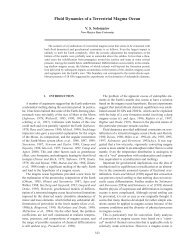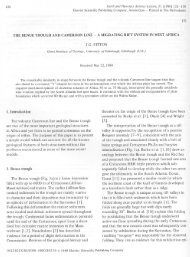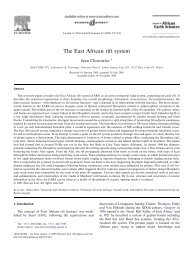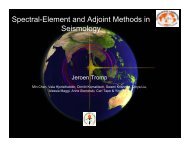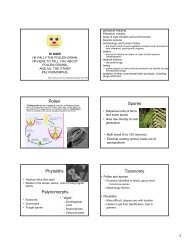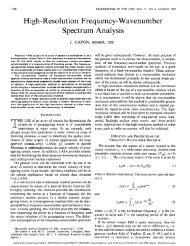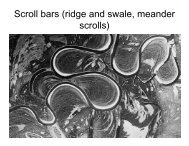Directional Recording of Swell from Distant Storms - Department of ...
Directional Recording of Swell from Distant Storms - Department of ...
Directional Recording of Swell from Distant Storms - Department of ...
Create successful ePaper yourself
Turn your PDF publications into a flip-book with our unique Google optimized e-Paper software.
556 W. H. MUNK, G. R. MILLER, F. E. SNODGRASS AND N. F. BARBERThere are three main source areas: the Ross Sea, the New Zealand-Australia-Antarcticsector, and the antipodal region. No sources east <strong>of</strong> the Ross Sea were found, but thesewould be discriminated against by refraction. For most sources <strong>of</strong>f the Ross Sea the weatherinformation was entirely inadequate to check the wave observations. In all other instancesit has been possible to associate the wave-inferred sources with observed storms. Often theweather information is so sparse and the location <strong>of</strong> storm centres so indefinite that thecomparison is not convincing. The weather maps show storms at least as intense as thoseyielding a ridge line, yet not being associated with a well-defined feature on the E(f, t)diagrams. Major ridge lines stand out more impressively above the spectral backgroundthan do the associated storms stand out above the run-<strong>of</strong>-the-mill storm. Perhaps this is areflexion <strong>of</strong> the fact that the power absorbed in the waves is proportional to a high moment<strong>of</strong> the wind speed, presumbly the fourth moment. It might also indicate that very highwinds are concentrated in space and time, and are likely to be missed in a loose observationalgrid. In some sense the wave observations may yield a more reliable though biased indication<strong>of</strong> the storm system than the weather observations themselves.Two wave-inferred sources are on land: 4 5 and 1 1I6 <strong>of</strong> September. The computed directionsare 2000, whereas the nearest storm systems would indicate directions <strong>of</strong> 210 to 2150.The distances agree. In many other instances the storms lie to the west <strong>of</strong>the inferred sources.We now consider some individual cases.(a) The hurricane <strong>of</strong> 23 OctoberAccording to figure 17 the time <strong>of</strong> origin was early on 23 October 1959 (U.T.) and thedistance 59?. The direction is best estimated <strong>from</strong> figure 23. The well-defined peaks at47.5 and 58 6c/ks suggest an <strong>of</strong>f-shore direction between 290 and 3000. At 35c/ks thedirectional histogram is split in three parts. At 25 c/ks, the lowest recorded frequency, therefractive effects are so dominant that little can be inferred concerning <strong>of</strong>f-shore direction,but as far as the evidence goes it is consistent with the foregoing estimate. With regard towave direction the present example is not typical because <strong>of</strong> the extreme refraction.We set=to 23-2 August, A = 590, 00 = 2950,as our estimate based on the wave records. Copies <strong>of</strong> weather maps in the critical area areplotted on figure 34. A hurricane with 55 knot winds appears on the map <strong>of</strong> 23 October.There is no indication <strong>of</strong> this storm on the preceding day. On 24 October the storm hasmoved east and the winds are somewhat weaker. By 25 October the storm had weakenedconsiderably. Our estimates <strong>from</strong> weather maps areto =23 August, AL= 600, 0= 3000,and these are in fair agreement with the parameters deduced <strong>from</strong> the wave records.The observed duration is roughly in accord with the wave observations. The effect <strong>of</strong> therapid approach along the line <strong>of</strong> site is to steepen and sharpen the ridge at a frequencyfwhose group velocity V(f) equals the velocity <strong>of</strong> approach. This is discussed in more detailin connexion with the rapidly moving source <strong>of</strong> 12y4 May (see ? 11 (c), figure 36). Thevelocity <strong>of</strong> approach is 35 knots, and the expected focus is at 49 c/ks. This is in accord withthe ridge contours.




